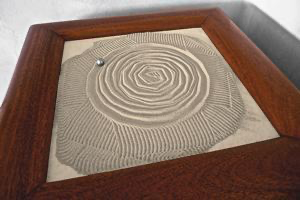| Showing 1 of 1 |
|
Jean-Pierre Hebert
French/American
(1939–2021)
Sisyphe
1998-2004
Mahogany, sand, aluminum, canvas, Mac mini computer, custom electronics,etc
6.5 x 27.5 x 27.5 in. (16.51 x 69.85 x 69.85 cm)
Gift of the Kathryn C. Wanlass Foundation
2010.12
As a conceptual artist, Jean-Pierre Hébert defines the act of drawing as a “mental activity” rather than as a gesture or skill. Although he began his career making traditional drawings on paper, Hébert turned to digital technology in the 1970s, when he started experimenting with computer programs to create drawings using a plotter. Since the 1990s, he has often used sand as a drawing surface and, around 1998, he developed a system for making what he calls “digital Zen gardens.” Sisyphe is the third iteration of his original idea. In examples such as Sisyphe, a drawing is generated by a small aluminum ball that moves mechanically through sand housed in a mahogany box, producing line patterns similar to the raked markings in a Zen garden. The ball’s movement is controlled by a magnet attached to motorized metal beams on the box’s underside. Each time a new drawing is created, the previous one is erased, suggesting the Buddhist idea that all things are impermanent and constantly changing. The idea of an ongoing cycle of creation, destruction, and creation is also reflected in the title, which refers to the Greek myth of Sisyphus, the deceitful king whose punishment involved rolling a heavy boulder up a hill only to witness it roll back down, so that he had to start all over again, a sequence that repeated
for eternity.
In developing the software programs for his mechanical sand drawings, Hébert sees his role as being similar to that of a composer or choreographer. For him, writing the algorithmic code that controls the machine’s operation is the equivalent of notating a musical score or directing a dance, with each new drawing becoming a unique performance.
David S. Rubin
- Collecting on the Edge , 9/15/2018 - 5/4/2019
- Collecting on the Edge Part II Nora Eccles Harrison Museum of Art , 1/17/2019 - 5/4/2019
This object is a member of the following portfolios:
Your current search criteria is: Related to "Jean-Pierre Hebert".


